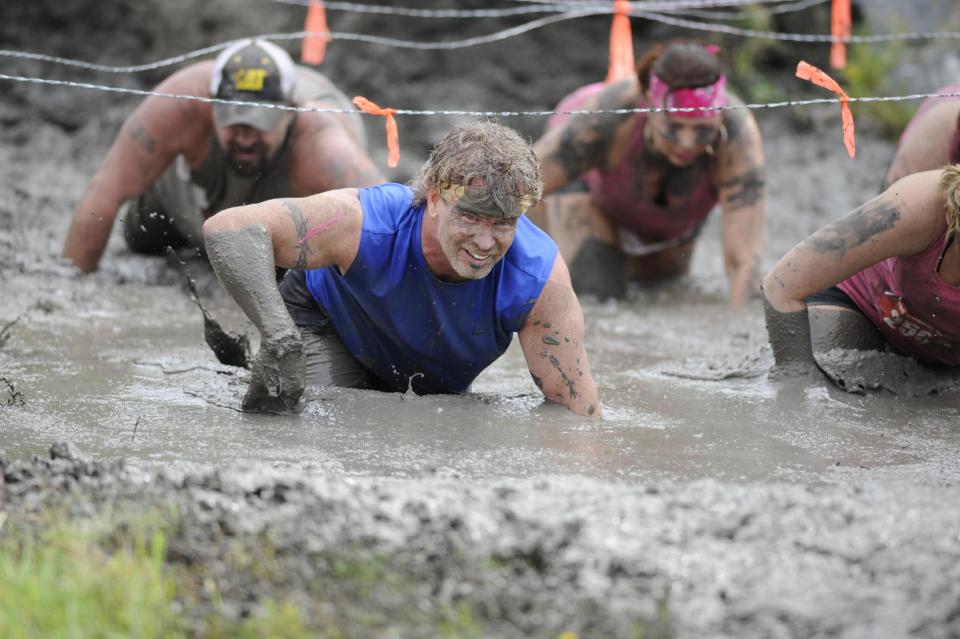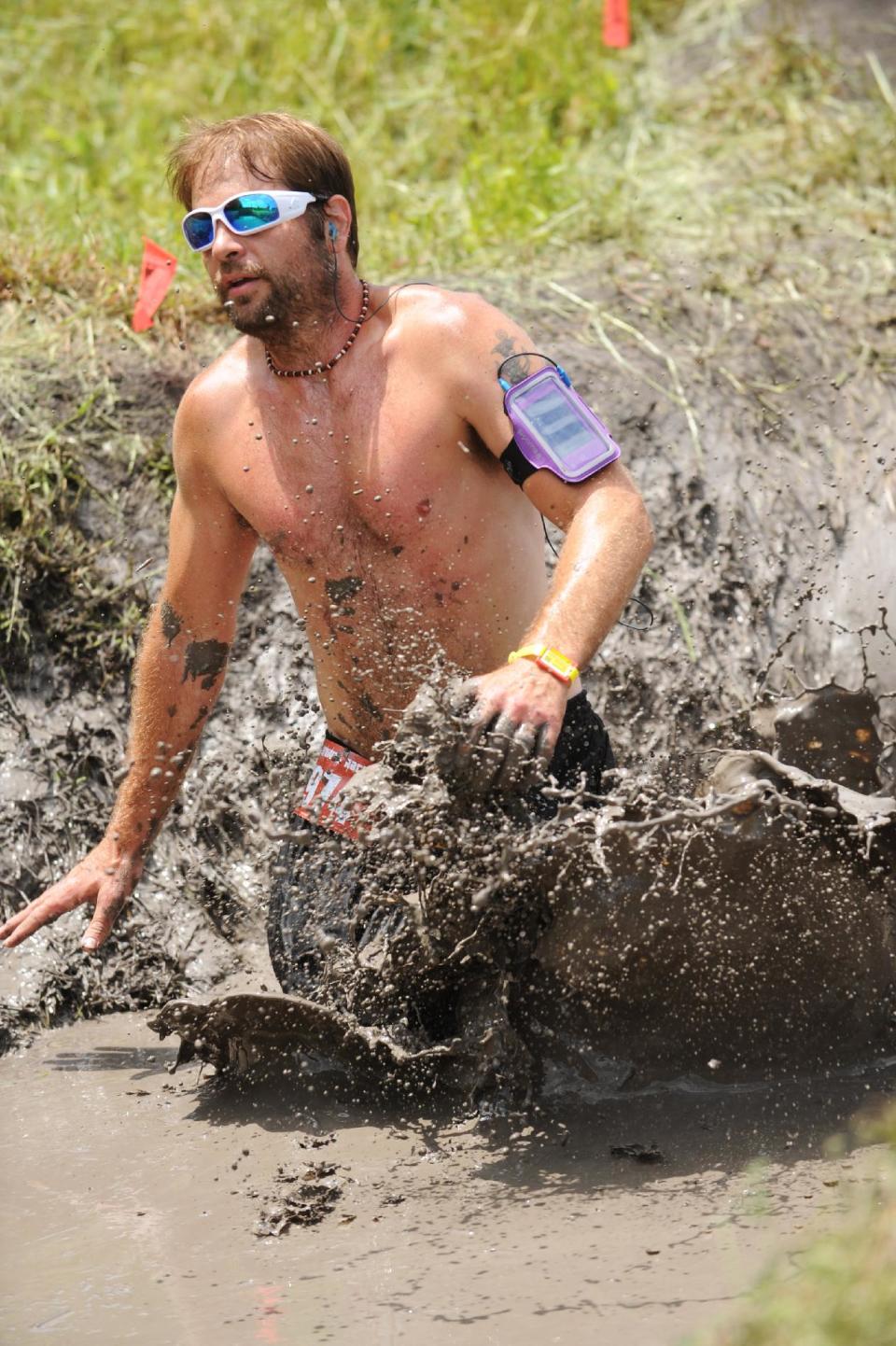Obstacle course racing growing in popularity
PHOENIX (AP) — Obstacle course runners start on their feet, but eventually end up on their stomachs, sides, even backs at they clamber through mud, over shipping containers, across netting made of mangled ropes.
The most mentally strong will choose courses where they have to jump off large platforms into water, run across fire, even crawl through water as live wires zap them from above.
Sound like fun?
OK, burning and shocking may not be for everyone, but not all obstacle course races are that intense.
Most are filled with obstacles that are challenging but not painful, providing a good test of strength, stamina and mental toughness in a way that's fun and as demanding as the competitors want it to be.
And for those who make it across the finish line, the can't-believe-I-just-did-that reward is usually worth all the agony.
"It challenges your cardio, it challenges you muscularly and challenges you mentally," said Michael Sandercock, founder of obstacleracers.com. "To start out wondering if you can get through everything and push beyond what you thought were your limits is really a good feeling for people."
Obstacle course races have been around pretty much since the dawn of civilized society; the ancient Greeks had a race called the Stadion, where runners ran naked around a track covered with obstacles.
The Stadion was once part of the five events in the Olympic Pentathlon, and obstacle course races — with clothes — continued through the centuries. The races also became staples of military training, the variety of maneuvers a perfect blend for getting troops ready for the multitude of challenges they might face in the field.
The current trend in obstacle racing started a few years ago, when elite athletes started looking for new challenges, ones without the joint-jarring pain of long-distance running or the cost of triathlons.
The Spartan Race, created in 2005 by seven ultra athletes and a Royal Marine, was one of the first major obstacle course races, and The Warrior Dash and Tough Mudder races weren't far behind.
Now there are over 50 races and series across the United States, from the difficult, fire-and-electricity types to entertainment-slanted ones like the Run for Your Lives 5K, where participants are chased by zombies.
"It's really taken off in the past three years or so," said James Villepigue, co-owner of one event called The Survival Race, and author of the "Obstacle Race Training Bible" (Alpha, 2012). "I think we're hitting critical mass now with races popping up everywhere."
Obstacle course races are all based on the same basic principles — testing competitors' limits in unique ways — but there is a wide variety of distances and types of obstacles.
Many, like The Survival Race and Warrior Dash, are more family-oriented, with shorter distances and obstacles that aren't too punishing, such as climbing walls and cargo nets, going through mud pits, scrambling up and over shipping containers — sometimes with a net in between — and running through tires like prospective professional football players do at the NFL combine.
The races often have live bands playing throughout the day, food and equipment vendors, sometimes even beer to enjoy with fellow competitors after the race.
The difficult obstacle course races are run over longer distances and have more challenging obstacles, such as climbing ropes, carrying heavy objects like tires and sandbags, and crawling under barbed wire.
The Tough Mudder races, arguably the most difficult in the genre, feature up to 25 obstacles along courses that cover 10 or more miles, including a plunge into a dumpster filled with ice water and a sprint through fire. The series, which has over 50 events in several countries, also has the shocking obstacles: live wires carrying up to 10,000 volts of electricity hanging in a tunnel that runners have to go through, and a crawl through frigid water with more live wires hanging above.
But even some of the toughest races have a range of distances and challenges.
The Spartan Race series, which has three dozen races in Canada and the United States this year, includes four distances, from 3 to 26 miles, and many other races include shorter versions and kid runs.
Of course, there are always those athletes who want the ultimate challenge, so for them there's the Spartan Death Race, which last 48 hours, and the World's Toughest Mudder, an invitation-only race that lasts 24 hours.
"Depending on your athletic ability, you can choose these races and pretty much find something that will suit where you're at at the moment," said Sandercock, a mechanical engineer from Milwaukee who created his website to help fellow obstacle course racers keep track of upcoming races.
Whatever the distance or difficulty of the obstacles, these races require a decent level of fitness.
Villepigue has been a personal trainer for over 20 years and gets his clients ready for races with workouts that focus more on time than a certain number of repetitions. He gears workouts toward the movements they'll need during the race, like building upper-body strength (to climb ropes), planking exercises that include dragging the lower body (for mud pit crawls), and running up and walking down steep hills.
Sandercock, who's training for an Ironman Triathlon, focuses on running because the obstacles are often spread out, and cross training, working on cardio and strength so his energy doesn't get sapped on the more difficult obstacles.
"It's not easy," said Villepigue, who lives in East Northport, N.Y., and has authored more than 20 fitness-related books. "We have people who ran our race in Dallas last weekend — very athletic people — who said, 'Man, I didn't expect it to be that difficult.' But it's up to the person how hard they want to go at it."
The pain can be worth it.




